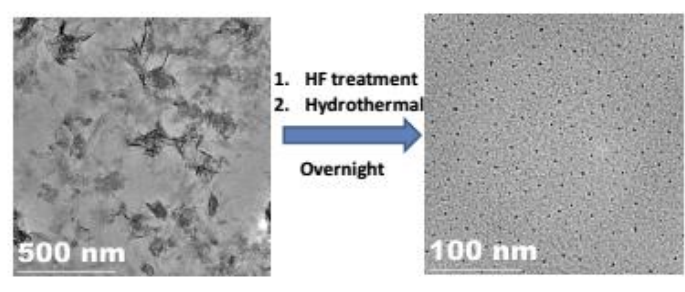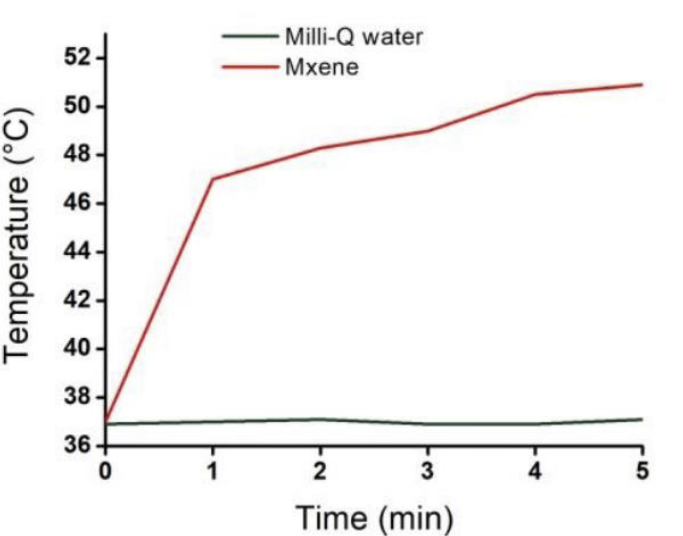This is an innovative method for synthesizing stable MXene quantum dots (QDs), which are nanoscale particles, suitable for various applications. The process involves two primary steps: initially producing MXene nanosheets through a chemical slicing process aided by hydrofluoric acid (HF) treatment and sonication, followed by the conversion of these nanosheets into QDs via chemical slicing and hydrothermal processes. Additionally, the invention proposes a technique for exfoliating titanium aluminum carbide (Ti3AlC2) into nanosheets using a combination of etching and mechanical force-assisted liquid exfoliation. The resulting MXene QDs exhibit high stability and responsiveness to Near Infra Red (NIR) light. This method offers a practical and efficient means of synthesizing MXene quantum dots with desirable properties.
Traditional metallic nanostructures face significant challenges including poor stability, low optical properties, easy aggregation, and uncontrolled particle size and morphology. While Ti3AlC2 MXenes show promise in photothermal therapy (PTT) applications, they primarily exhibit single photothermal-conversion functionality. There is a need to enhance their multifunctionality to broaden their scope in nanomedicine.
Fabricating highly dispersible and stable MXene quantum dots (QDs) through a straightforward and reliable process has not been achieved yet. Developing MXenes integrated with other functional moieties remains a challenge. This is necessary to create multifunctional MXenes that can perform multiple roles.
- This innovation provides a simple and effective method for producing MXene QDs from MXene nanosheets through chemical slicing and hydrothermal processes. It simplifies MXene nanosheet production by demonstrating a new approach to exfoliate Ti3AlC2, offering a practical route for large-scale production.
- The controlled morphology and highly uniform particle size distribution of QDs leads to better aqueous distribution, enhancing their performance and versatility.
- The MXene QDs form a clear and stable aqueous suspension in Milli-Q water (0.5 mg/ml), indicating excellent colloidal stability. The zeta potential measurement of approximately -21 confirms the high stability and dispersion of the QDs in aqueous solutions.
- High stability and responsiveness to NIR light makes them ideal for photothermal therapy against cancer.
- The MXene QDs exhibit a notable photothermal response when exposed to NIR light (808 nm with 1 W/cm² density). They achieve a significant temperature increase, reaching approximately 50 °C within 5 minutes of irradiation, indicating efficient photothermal conversion.
The MXene QDs, synthesized from the nanosheets using chemical slicing and hydrothermal processes, exhibit a uniform size distribution ranging from 6-10 nm.
MXene QDs have been synthesized in the lab, and their photothermal performance has been tested.
- Advancement in Cancer Therapy: The development of stable and responsive MXene QDs could significantly advance cancer therapy, particularly in photothermal treatments. These QDs, with their NIR responsiveness, controlled morphology, and uniform distribution, hold potential for precise and effective tumor targeting, reducing side effects, and improving patient outcomes.
- Environmental Safety: By utilizing aqueous solvents and eliminating the need for harmful organic solvents like dimethylsulfoxide (DMSO) and chloroform, the synthesis process enhances environmental safety.
- Scalability: It offers broader accessibility, potentially lowering the cost of production, and facilitating widespread adoption in medical facilities worldwide.
There are various applications in nanomedicine in photothermal therapy.
Geography of IP
Type of IP
202021029875
462594


